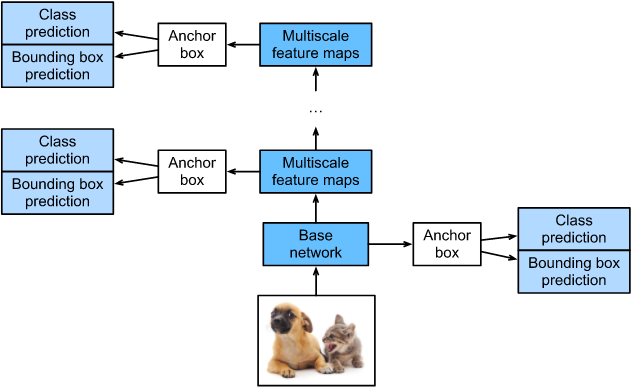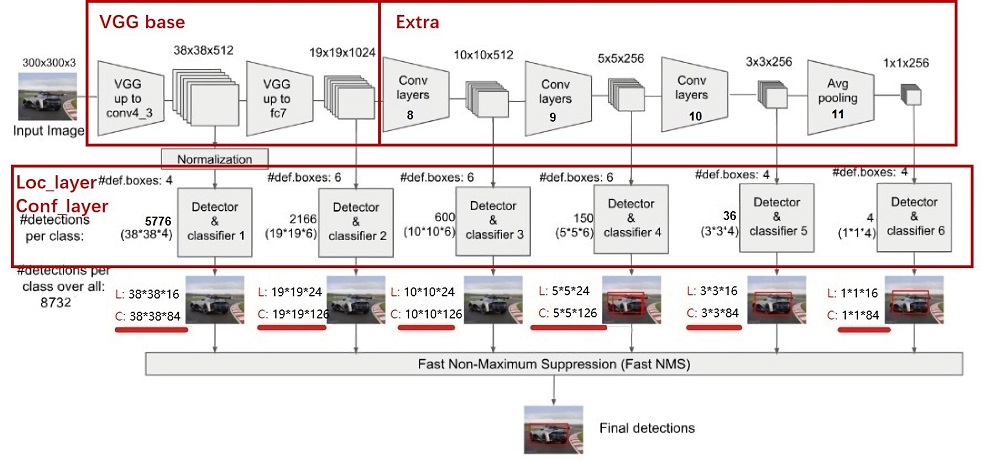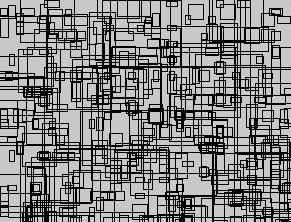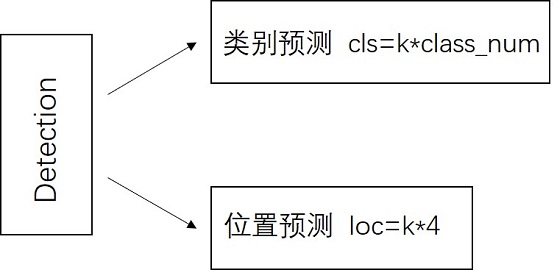模型简介
SSD,全称Single Shot MultiBox Detector,其目标检测主流算法分成可以两个类型:
1. two-stage方法:RCNN系列通过算法产生候选框,然后再对这些候选框进行分类和回归
2. one-stage方法:YOLO和SSD直接通过主干网络给出类别位置信息,不需要区域生成
SSD是单阶段的目标检测算法,通过卷积神经网络进行特征提取,取不同的特征层进行检测输出,所以SSD是一种多尺度的检测方法。在需要检测的特征层,直接使用一个3×3卷积,进行通道的变换。SSD采用了anchor的策略,预设不同长宽比例的anchor,每一个输出特征层基于anchor预测多个检测框(4或者6)。采用了多尺度检测方法,浅层用于检测小目标,深层用于检测大目标。SSD的框架如下图:
模型结构
SSD采用VGG16作为基础模型,然后在VGG16的基础上新增了卷积层来获得更多的特征图以用于检测。SSD的网络结构如图所示。上面是SSD模型,下面是YOLO模型,可以明显看到SSD利用了多尺度的特征图做检测。
两种单阶段目标检测算法的比较:
SSD先通过卷积不断进行特征提取,在需要检测物体的网络,直接通过一个3×3卷积得到输出,卷积的通道数由anchor数量和类别数量决定,具体为(anchor数量*(类别数量+4))。
SSD对比了YOLO系列目标检测方法,不同的是SSD通过卷积得到最后的边界框,而YOLO对最后的输出采用全连接的形式得到一维向量,对向量进行拆解得到最终的检测框。
模型特点
多尺度检测
在SSD的网络结构图中可以看到,SSD使用了多个特征层。大尺度特征图(较靠前的特征图)可以用来检测小物体,而小尺度特征图(较靠后的特征图)用来检测大物体。多尺度检测的方式,可以使得检测更加充分(SSD属于密集检测),更能检测出小目标。
采用卷积进行检测
与YOLO最后采用全连接层不同,SSD直接采用卷积对不同的特征图来进行提取检测结果。
预设anchor
在SSD中,采用预设边界框,预测框的尺寸在anchor的指导下进行微调。
数据准备与处理
使用的数据集为COCO 2017
from download import download
dataset_url = "https://mindspore-website.obs.cn-north-4.myhuaweicloud.com/notebook/datasets/ssd_datasets.zip"
path = "./"
path = download(dataset_url, path, kind="zip", replace=True)
coco_root = "./datasets/"
anno_json = "./datasets/annotations/instances_val2017.json"
train_cls = ['background', 'person', 'bicycle', 'car', 'motorcycle', 'airplane', 'bus',
'train', 'truck', 'boat', 'traffic light', 'fire hydrant',
'stop sign', 'parking meter', 'bench', 'bird', 'cat', 'dog',
'horse', 'sheep', 'cow', 'elephant', 'bear', 'zebra',
'giraffe', 'backpack', 'umbrella', 'handbag', 'tie',
'suitcase', 'frisbee', 'skis', 'snowboard', 'sports ball',
'kite', 'baseball bat', 'baseball glove', 'skateboard',
'surfboard', 'tennis racket', 'bottle', 'wine glass', 'cup',
'fork', 'knife', 'spoon', 'bowl', 'banana', 'apple',
'sandwich', 'orange', 'broccoli', 'carrot', 'hot dog', 'pizza',
'donut', 'cake', 'chair', 'couch', 'potted plant', 'bed',
'dining table', 'toilet', 'tv', 'laptop', 'mouse', 'remote',
'keyboard', 'cell phone', 'microwave', 'oven', 'toaster', 'sink',
'refrigerator', 'book', 'clock', 'vase', 'scissors',
'teddy bear', 'hair drier', 'toothbrush']
train_cls_dict = {}
for i, cls in enumerate(train_cls):
train_cls_dict[cls] = i数据采样
为了使模型对于各种输入对象大小和形状更加鲁棒,SSD算法每个训练图像通过以下选项之一随机采样:
-
使用整个原始输入图像
-
采样一个区域,使采样区域和原始图片最小的交并比重叠为0.1,0.3,0.5,0.7或0.9
-
随机采样一个区域
每个采样区域的大小为原始图像大小的[0.3,1],长宽比在1/2和2之间。如果真实标签框中心在采样区域内,则保留两者重叠部分作为新图片的真实标注框。在上述采样步骤之后,将每个采样区域大小调整为固定大小,并以0.5的概率水平翻转。
import cv2
import numpy as np
def _rand(a=0., b=1.):
return np.random.rand() * (b - a) + a
def intersect(box_a, box_b):
"""Compute the intersect of two sets of boxes."""
max_yx = np.minimum(box_a[:, 2:4], box_b[2:4])
min_yx = np.maximum(box_a[:, :2], box_b[:2])
inter = np.clip((max_yx - min_yx), a_min=0, a_max=np.inf)
return inter[:, 0] * inter[:, 1]
def jaccard_numpy(box_a, box_b):
"""Compute the jaccard overlap of two sets of boxes."""
inter = intersect(box_a, box_b)
area_a = ((box_a[:, 2] - box_a[:, 0]) *
(box_a[:, 3] - box_a[:, 1]))
area_b = ((box_b[2] - box_b[0]) *
(box_b[3] - box_b[1]))
union = area_a + area_b - inter
return inter / union
def random_sample_crop(image, boxes):
"""Crop images and boxes randomly."""
height, width, _ = image.shape
min_iou = np.random.choice([None, 0.1, 0.3, 0.5, 0.7, 0.9])
if min_iou is None:
return image, boxes
for _ in range(50):
image_t = image
w = _rand(0.3, 1.0) * width
h = _rand(0.3, 1.0) * height
# aspect ratio constraint b/t .5 & 2
if h / w < 0.5 or h / w > 2:
continue
left = _rand() * (width - w)
top = _rand() * (height - h)
rect = np.array([int(top), int(left), int(top + h), int(left + w)])
overlap = jaccard_numpy(boxes, rect)
# dropout some boxes
drop_mask = overlap > 0
if not drop_mask.any():
continue
if overlap[drop_mask].min() < min_iou and overlap[drop_mask].max() > (min_iou + 0.2):
continue
image_t = image_t[rect[0]:rect[2], rect[1]:rect[3], :]
centers = (boxes[:, :2] + boxes[:, 2:4]) / 2.0
m1 = (rect[0] < centers[:, 0]) * (rect[1] < centers[:, 1])
m2 = (rect[2] > centers[:, 0]) * (rect[3] > centers[:, 1])
# mask in that both m1 and m2 are true
mask = m1 * m2 * drop_mask
# have any valid boxes? try again if not
if not mask.any():
continue
# take only matching gt boxes
boxes_t = boxes[mask, :].copy()
boxes_t[:, :2] = np.maximum(boxes_t[:, :2], rect[:2])
boxes_t[:, :2] -= rect[:2]
boxes_t[:, 2:4] = np.minimum(boxes_t[:, 2:4], rect[2:4])
boxes_t[:, 2:4] -= rect[:2]
return image_t, boxes_t
return image, boxes
def ssd_bboxes_encode(boxes):
"""Labels anchors with ground truth inputs."""
def jaccard_with_anchors(bbox):
"""Compute jaccard score a box and the anchors."""
# Intersection bbox and volume.
ymin = np.maximum(y1, bbox[0])
xmin = np.maximum(x1, bbox[1])
ymax = np.minimum(y2, bbox[2])
xmax = np.minimum(x2, bbox[3])
w = np.maximum(xmax - xmin, 0.)
h = np.maximum(ymax - ymin, 0.)
# Volumes.
inter_vol = h * w
union_vol = vol_anchors + (bbox[2] - bbox[0]) * (bbox[3] - bbox[1]) - inter_vol
jaccard = inter_vol / union_vol
return np.squeeze(jaccard)
pre_scores = np.zeros((8732), dtype=np.float32)
t_boxes = np.zeros((8732, 4), dtype=np.float32)
t_label = np.zeros((8732), dtype=np.int64)
for bbox in boxes:
label = int(bbox[4])
scores = jaccard_with_anchors(bbox)
idx = np.argmax(scores)
scores[idx] = 2.0
mask = (scores > matching_threshold)
mask = mask & (scores > pre_scores)
pre_scores = np.maximum(pre_scores, scores * mask)
t_label = mask * label + (1 - mask) * t_label
for i in range(4):
t_boxes[:, i] = mask * bbox[i] + (1 - mask) * t_boxes[:, i]
index = np.nonzero(t_label)
# Transform to tlbr.
bboxes = np.zeros((8732, 4), dtype=np.float32)
bboxes[:, [0, 1]] = (t_boxes[:, [0, 1]] + t_boxes[:, [2, 3]]) / 2
bboxes[:, [2, 3]] = t_boxes[:, [2, 3]] - t_boxes[:, [0, 1]]
# Encode features.
bboxes_t = bboxes[index]
default_boxes_t = default_boxes[index]
bboxes_t[:, :2] = (bboxes_t[:, :2] - default_boxes_t[:, :2]) / (default_boxes_t[:, 2:] * 0.1)
tmp = np.maximum(bboxes_t[:, 2:4] / default_boxes_t[:, 2:4], 0.000001)
bboxes_t[:, 2:4] = np.log(tmp) / 0.2
bboxes[index] = bboxes_t
num_match = np.array([len(np.nonzero(t_label)[0])], dtype=np.int32)
return bboxes, t_label.astype(np.int32), num_match
def preprocess_fn(img_id, image, box, is_training):
"""Preprocess function for dataset."""
cv2.setNumThreads(2)
def _infer_data(image, input_shape):
img_h, img_w, _ = image.shape
input_h, input_w = input_shape
image = cv2.resize(image, (input_w, input_h))
# When the channels of image is 1
if len(image.shape) == 2:
image = np.expand_dims(image, axis=-1)
image = np.concatenate([image, image, image], axis=-1)
return img_id, image, np.array((img_h, img_w), np.float32)
def _data_aug(image, box, is_training, image_size=(300, 300)):
ih, iw, _ = image.shape
h, w = image_size
if not is_training:
return _infer_data(image, image_size)
# Random crop
box = box.astype(np.float32)
image, box = random_sample_crop(image, box)
ih, iw, _ = image.shape
# Resize image
image = cv2.resize(image, (w, h))
# Flip image or not
flip = _rand() < .5
if flip:
image = cv2.flip(image, 1, dst=None)
# When the channels of image is 1
if len(image.shape) == 2:
image = np.expand_dims(image, axis=-1)
image = np.concatenate([image, image, image], axis=-1)
box[:, [0, 2]] = box[:, [0, 2]] / ih
box[:, [1, 3]] = box[:, [1, 3]] / iw
if flip:
box[:, [1, 3]] = 1 - box[:, [3, 1]]
box, label, num_match = ssd_bboxes_encode(box)
return image, box, label, num_match
return _data_aug(image, box, is_training, image_size=[300, 300])数据集创建
from mindspore import Tensor
from mindspore.dataset import MindDataset
from mindspore.dataset.vision import Decode, HWC2CHW, Normalize, RandomColorAdjust
def create_ssd_dataset(mindrecord_file, batch_size=32, device_num=1, rank=0,
is_training=True, num_parallel_workers=1, use_multiprocessing=True):
"""Create SSD dataset with MindDataset."""
dataset = MindDataset(mindrecord_file, columns_list=["img_id", "image", "annotation"], num_shards=device_num,
shard_id=rank, num_parallel_workers=num_parallel_workers, shuffle=is_training)
decode = Decode()
dataset = dataset.map(operations=decode, input_columns=["image"])
change_swap_op = HWC2CHW()
# Computed from random subset of ImageNet training images
normalize_op = Normalize(mean=[0.485 * 255, 0.456 * 255, 0.406 * 255],
std=[0.229 * 255, 0.224 * 255, 0.225 * 255])
color_adjust_op = RandomColorAdjust(brightness=0.4, contrast=0.4, saturation=0.4)
compose_map_func = (lambda img_id, image, annotation: preprocess_fn(img_id, image, annotation, is_training))
if is_training:
output_columns = ["image", "box", "label", "num_match"]
trans = [color_adjust_op, normalize_op, change_swap_op]
else:
output_columns = ["img_id", "image", "image_shape"]
trans = [normalize_op, change_swap_op]
dataset = dataset.map(operations=compose_map_func, input_columns=["img_id", "image", "annotation"],
output_columns=output_columns, python_multiprocessing=use_multiprocessing,
num_parallel_workers=num_parallel_workers)
dataset = dataset.map(operations=trans, input_columns=["image"], python_multiprocessing=use_multiprocessing,
num_parallel_workers=num_parallel_workers)
dataset = dataset.batch(batch_size, drop_remainder=True)
return dataset模型构建
SSD的网络结构主要分为以下几个部分:
1. VGG16 Base Layer
2. Extra Feature Layer
3. Detection Layer
4. NMS
5. Anchor
Backbone Layer
Extra Feature Layer
在VGG16的基础上,SSD进一步增加了4个深度卷积层,用于提取更高层的语义信息:
Anchor
SSD采用了PriorBox来进行区域生成。将固定大小宽高的PriorBox作为先验的感兴趣区域,利用一个阶段完成能够分类与回归。PriorBox生成规则: SSD由6个特征层来检测目标,在不同特征层上,PriorBox的尺寸scale大小是不一样的,最低层的scale=0.1,最高层的scale=0.95,其他层的计算公式如下:
在某个特征层上其scale一定,那么会设置不同长宽比ratio的PriorBox,其长和宽的计算公式如下:
每个特征层的每个点都会以上述规则生成PriorBox,(cx,cy)由当前点的中心点来确定,由此每个特征层都生成大量密集的PriorBox,如下图:
SSD使用了第4、7、8、9、10和11这6个卷积层得到的特征图,这6个特征图尺寸越来越小,而其对应的感受野越来越大。6个特征图上的每一个点分别对应4、6、6、6、4、4个PriorBox。某个特征图上的一个点根据下采样率可以得到在原图的坐标,以该坐标为中心生成4个或6个不同大小的PriorBox,然后利用特征图的特征去预测每一个PriorBox对应类别与位置的预测量。
Detection Layer
代码实现:
from mindspore import nn
def _make_layer(channels):
in_channels = channels[0]
layers = []
for out_channels in channels[1:]:
layers.append(nn.Conv2d(in_channels=in_channels, out_channels=out_channels, kernel_size=3))
layers.append(nn.ReLU())
in_channels = out_channels
return nn.SequentialCell(layers)
class Vgg16(nn.Cell):
"""VGG16 module."""
def __init__(self):
super(Vgg16, self).__init__()
self.b1 = _make_layer([3, 64, 64])
self.b2 = _make_layer([64, 128, 128])
self.b3 = _make_layer([128, 256, 256, 256])
self.b4 = _make_layer([256, 512, 512, 512])
self.b5 = _make_layer([512, 512, 512, 512])
self.m1 = nn.MaxPool2d(kernel_size=2, stride=2, pad_mode='SAME')
self.m2 = nn.MaxPool2d(kernel_size=2, stride=2, pad_mode='SAME')
self.m3 = nn.MaxPool2d(kernel_size=2, stride=2, pad_mode='SAME')
self.m4 = nn.MaxPool2d(kernel_size=2, stride=2, pad_mode='SAME')
self.m5 = nn.MaxPool2d(kernel_size=3, stride=1, pad_mode='SAME')
def construct(self, x):
# block1
x = self.b1(x)
x = self.m1(x)
# block2
x = self.b2(x)
x = self.m2(x)
# block3
x = self.b3(x)
x = self.m3(x)
# block4
x = self.b4(x)
block4 = x
x = self.m4(x)
# block5
x = self.b5(x)
x = self.m5(x)
return block4, ximport mindspore as ms
import mindspore.nn as nn
import mindspore.ops as ops
def _last_conv2d(in_channel, out_channel, kernel_size=3, stride=1, pad_mod='same', pad=0):
in_channels = in_channel
out_channels = in_channel
depthwise_conv = nn.Conv2d(in_channels, out_channels, kernel_size, stride, pad_mode='same',
padding=pad, group=in_channels)
conv = nn.Conv2d(in_channel, out_channel, kernel_size=1, stride=1, padding=0, pad_mode='same', has_bias=True)
bn = nn.BatchNorm2d(in_channel, eps=1e-3, momentum=0.97,
gamma_init=1, beta_init=0, moving_mean_init=0, moving_var_init=1)
return nn.SequentialCell([depthwise_conv, bn, nn.ReLU6(), conv])
class FlattenConcat(nn.Cell):
"""FlattenConcat module."""
def __init__(self):
super(FlattenConcat, self).__init__()
self.num_ssd_boxes = 8732
def construct(self, inputs):
output = ()
batch_size = ops.shape(inputs[0])[0]
for x in inputs:
x = ops.transpose(x, (0, 2, 3, 1))
output += (ops.reshape(x, (batch_size, -1)),)
res = ops.concat(output, axis=1)
return ops.reshape(res, (batch_size, self.num_ssd_boxes, -1))
class MultiBox(nn.Cell):
"""
Multibox conv layers. Each multibox layer contains class conf scores and localization predictions.
"""
def __init__(self):
super(MultiBox, self).__init__()
num_classes = 81
out_channels = [512, 1024, 512, 256, 256, 256]
num_default = [4, 6, 6, 6, 4, 4]
loc_layers = []
cls_layers = []
for k, out_channel in enumerate(out_channels):
loc_layers += [_last_conv2d(out_channel, 4 * num_default[k],
kernel_size=3, stride=1, pad_mod='same', pad=0)]
cls_layers += [_last_conv2d(out_channel, num_classes * num_default[k],
kernel_size=3, stride=1, pad_mod='same', pad=0)]
self.multi_loc_layers = nn.CellList(loc_layers)
self.multi_cls_layers = nn.CellList(cls_layers)
self.flatten_concat = FlattenConcat()
def construct(self, inputs):
loc_outputs = ()
cls_outputs = ()
for i in range(len(self.multi_loc_layers)):
loc_outputs += (self.multi_loc_layers[i](inputs[i]),)
cls_outputs += (self.multi_cls_layers[i](inputs[i]),)
return self.flatten_concat(loc_outputs), self.flatten_concat(cls_outputs)
class SSD300Vgg16(nn.Cell):
"""SSD300Vgg16 module."""
def __init__(self):
super(SSD300Vgg16, self).__init__()
# VGG16 backbone: block1~5
self.backbone = Vgg16()
# SSD blocks: block6~7
self.b6_1 = nn.Conv2d(in_channels=512, out_channels=1024, kernel_size=3, padding=6, dilation=6, pad_mode='pad')
self.b6_2 = nn.Dropout(p=0.5)
self.b7_1 = nn.Conv2d(in_channels=1024, out_channels=1024, kernel_size=1)
self.b7_2 = nn.Dropout(p=0.5)
# Extra Feature Layers: block8~11
self.b8_1 = nn.Conv2d(in_channels=1024, out_channels=256, kernel_size=1, padding=1, pad_mode='pad')
self.b8_2 = nn.Conv2d(in_channels=256, out_channels=512, kernel_size=3, stride=2, pad_mode='valid')
self.b9_1 = nn.Conv2d(in_channels=512, out_channels=128, kernel_size=1, padding=1, pad_mode='pad')
self.b9_2 = nn.Conv2d(in_channels=128, out_channels=256, kernel_size=3, stride=2, pad_mode='valid')
self.b10_1 = nn.Conv2d(in_channels=256, out_channels=128, kernel_size=1)
self.b10_2 = nn.Conv2d(in_channels=128, out_channels=256, kernel_size=3, pad_mode='valid')
self.b11_1 = nn.Conv2d(in_channels=256, out_channels=128, kernel_size=1)
self.b11_2 = nn.Conv2d(in_channels=128, out_channels=256, kernel_size=3, pad_mode='valid')
# boxes
self.multi_box = MultiBox()
def construct(self, x):
# VGG16 backbone: block1~5
block4, x = self.backbone(x)
# SSD blocks: block6~7
x = self.b6_1(x) # 1024
x = self.b6_2(x)
x = self.b7_1(x) # 1024
x = self.b7_2(x)
block7 = x
# Extra Feature Layers: block8~11
x = self.b8_1(x) # 256
x = self.b8_2(x) # 512
block8 = x
x = self.b9_1(x) # 128
x = self.b9_2(x) # 256
block9 = x
x = self.b10_1(x) # 128
x = self.b10_2(x) # 256
block10 = x
x = self.b11_1(x) # 128
x = self.b11_2(x) # 256
block11 = x
# boxes
multi_feature = (block4, block7, block8, block9, block10, block11)
pred_loc, pred_label = self.multi_box(multi_feature)
if not self.training:
pred_label = ops.sigmoid(pred_label)
pred_loc = pred_loc.astype(ms.float32)
pred_label = pred_label.astype(ms.float32)
return pred_loc, pred_label损失函数
SSD算法的目标函数分为两部分:计算相应的预选框与目标类别的置信度误差以及相应的位置误差:
其中:
N 是先验框的正样本数量;
c 为类别置信度预测值;
l 为先验框的所对应边界框的位置预测值;
g 为ground truth的位置参数
α 用以调整confidence loss和location loss之间的比例,默认为1。
对于位置损失函数
针对所有的正样本,采用 Smooth L1 Loss, 位置信息都是 encode 之后的位置信息。
对于置信度损失函数
置信度损失是多类置信度(c)上的softmax损失。
代码实现:
def class_loss(logits, label):
"""Calculate category losses."""
label = ops.one_hot(label, ops.shape(logits)[-1], Tensor(1.0, ms.float32), Tensor(0.0, ms.float32))
weight = ops.ones_like(logits)
pos_weight = ops.ones_like(logits)
sigmiod_cross_entropy = ops.binary_cross_entropy_with_logits(logits, label, weight.astype(ms.float32), pos_weight.astype(ms.float32))
sigmoid = ops.sigmoid(logits)
label = label.astype(ms.float32)
p_t = label * sigmoid + (1 - label) * (1 - sigmoid)
modulating_factor = ops.pow(1 - p_t, 2.0)
alpha_weight_factor = label * 0.75 + (1 - label) * (1 - 0.75)
focal_loss = modulating_factor * alpha_weight_factor * sigmiod_cross_entropy
return focal_lossMetrics
在SSD中,训练过程是不需要用到非极大值抑制(NMS),但当进行检测时,例如输入一张图片要求输出框的时候,需要用到NMS过滤掉那些重叠度较大的预测框。
非极大值抑制的流程如下:
1. 根据置信度得分进行排序
2. 选择置信度最高的比边界框添加到最终输出列表中,将其从边界框列表中删除
3. 计算所有边界框的面积
4. 计算置信度最高的边界框与其他候选框的IoU
5. 删除IoU大于阈值的边界框
6. 重复上述操作,直至边界框列表为空
代码实现:
import json
from pycocotools.coco import COCO
from pycocotools.cocoeval import COCOeval
def apply_eval(eval_param_dict):
net = eval_param_dict["net"]
net.set_train(False)
ds = eval_param_dict["dataset"]
anno_json = eval_param_dict["anno_json"]
coco_metrics = COCOMetrics(anno_json=anno_json,
classes=train_cls,
num_classes=81,
max_boxes=100,
nms_threshold=0.6,
min_score=0.1)
for data in ds.create_dict_iterator(output_numpy=True, num_epochs=1):
img_id = data['img_id']
img_np = data['image']
image_shape = data['image_shape']
output = net(Tensor(img_np))
for batch_idx in range(img_np.shape[0]):
pred_batch = {
"boxes": output[0].asnumpy()[batch_idx],
"box_scores": output[1].asnumpy()[batch_idx],
"img_id": int(np.squeeze(img_id[batch_idx])),
"image_shape": image_shape[batch_idx]
}
coco_metrics.update(pred_batch)
eval_metrics = coco_metrics.get_metrics()
return eval_metrics
def apply_nms(all_boxes, all_scores, thres, max_boxes):
"""Apply NMS to bboxes."""
y1 = all_boxes[:, 0]
x1 = all_boxes[:, 1]
y2 = all_boxes[:, 2]
x2 = all_boxes[:, 3]
areas = (x2 - x1 + 1) * (y2 - y1 + 1)
order = all_scores.argsort()[::-1]
keep = []
while order.size > 0:
i = order[0]
keep.append(i)
if len(keep) >= max_boxes:
break
xx1 = np.maximum(x1[i], x1[order[1:]])
yy1 = np.maximum(y1[i], y1[order[1:]])
xx2 = np.minimum(x2[i], x2[order[1:]])
yy2 = np.minimum(y2[i], y2[order[1:]])
w = np.maximum(0.0, xx2 - xx1 + 1)
h = np.maximum(0.0, yy2 - yy1 + 1)
inter = w * h
ovr = inter / (areas[i] + areas[order[1:]] - inter)
inds = np.where(ovr <= thres)[0]
order = order[inds + 1]
return keep
class COCOMetrics:
"""Calculate mAP of predicted bboxes."""
def __init__(self, anno_json, classes, num_classes, min_score, nms_threshold, max_boxes):
self.num_classes = num_classes
self.classes = classes
self.min_score = min_score
self.nms_threshold = nms_threshold
self.max_boxes = max_boxes
self.val_cls_dict = {i: cls for i, cls in enumerate(classes)}
self.coco_gt = COCO(anno_json)
cat_ids = self.coco_gt.loadCats(self.coco_gt.getCatIds())
self.class_dict = {cat['name']: cat['id'] for cat in cat_ids}
self.predictions = []
self.img_ids = []
def update(self, batch):
pred_boxes = batch['boxes']
box_scores = batch['box_scores']
img_id = batch['img_id']
h, w = batch['image_shape']
final_boxes = []
final_label = []
final_score = []
self.img_ids.append(img_id)
for c in range(1, self.num_classes):
class_box_scores = box_scores[:, c]
score_mask = class_box_scores > self.min_score
class_box_scores = class_box_scores[score_mask]
class_boxes = pred_boxes[score_mask] * [h, w, h, w]
if score_mask.any():
nms_index = apply_nms(class_boxes, class_box_scores, self.nms_threshold, self.max_boxes)
class_boxes = class_boxes[nms_index]
class_box_scores = class_box_scores[nms_index]
final_boxes += class_boxes.tolist()
final_score += class_box_scores.tolist()
final_label += [self.class_dict[self.val_cls_dict[c]]] * len(class_box_scores)
for loc, label, score in zip(final_boxes, final_label, final_score):
res = {}
res['image_id'] = img_id
res['bbox'] = [loc[1], loc[0], loc[3] - loc[1], loc[2] - loc[0]]
res['score'] = score
res['category_id'] = label
self.predictions.append(res)
def get_metrics(self):
with open('predictions.json', 'w') as f:
json.dump(self.predictions, f)
coco_dt = self.coco_gt.loadRes('predictions.json')
E = COCOeval(self.coco_gt, coco_dt, iouType='bbox')
E.params.imgIds = self.img_ids
E.evaluate()
E.accumulate()
E.summarize()
return E.stats[0]
class SsdInferWithDecoder(nn.Cell):
"""
SSD Infer wrapper to decode the bbox locations."""
def __init__(self, network, default_boxes, ckpt_path):
super(SsdInferWithDecoder, self).__init__()
param_dict = ms.load_checkpoint(ckpt_path)
ms.load_param_into_net(network, param_dict)
self.network = network
self.default_boxes = default_boxes
self.prior_scaling_xy = 0.1
self.prior_scaling_wh = 0.2
def construct(self, x):
pred_loc, pred_label = self.network(x)
default_bbox_xy = self.default_boxes[..., :2]
default_bbox_wh = self.default_boxes[..., 2:]
pred_xy = pred_loc[..., :2] * self.prior_scaling_xy * default_bbox_wh + default_bbox_xy
pred_wh = ops.exp(pred_loc[..., 2:] * self.prior_scaling_wh) * default_bbox_wh
pred_xy_0 = pred_xy - pred_wh / 2.0
pred_xy_1 = pred_xy + pred_wh / 2.0
pred_xy = ops.concat((pred_xy_0, pred_xy_1), -1)
pred_xy = ops.maximum(pred_xy, 0)
pred_xy = ops.minimum(pred_xy, 1)
return pred_xy, pred_label训练过程
先验框匹配
在训练过程中,首先要确定训练图片中的ground truth(真实目标)与哪个先验框来进行匹配,与之匹配的先验框所对应的边界框将负责预测它。
SSD的先验框与ground truth的匹配原则主要有两点:
1. 对于图片中每个ground truth,找到与其IOU最大的先验框,该先验框与其匹配,这样可以保证每个ground truth一定与某个先验框匹配。通常称与ground truth匹配的先验框为正样本,反之,若一个先验框没有与任何ground truth进行匹配,那么该先验框只能与背景匹配,就是负样本
2. 对于剩余的未匹配先验框,若某个ground truth的IOU大于某个阈值(一般是0.5),那么该先验框也与这个ground truth进行匹配。尽管一个ground truth可以与多个先验框匹配,但是ground truth相对先验框还是太少了,所以负样本相对正样本会很多。为了保证正负样本尽量平衡,SSD采用了hard negative mining,就是对负样本进行抽样,抽样时按照置信度误差(预测背景的置信度越小,误差越大)进行降序排列,选取误差的较大的top-k作为训练的负样本,以保证正负样本比例接近1:3
注意:
1. 通常称与gt匹配的prior为正样本,反之,若某一个prior没有与任何一个gt匹配,则为负样本
2. 某个gt可以和多个prior匹配,而每个prior只能和一个gt进行匹配
3. 如果多个gt和某一个prior的IOU均大于阈值,那么prior只与IOU最大的那个进行匹配
如上图所示,训练过程中的 prior boxes 和 ground truth boxes 的匹配,基本思路是:让每一个 prior box 回归并且到 ground truth box,这个过程的调控我们需要损失层的帮助,他会计算真实值和预测值之间的误差,从而指导学习的走向。
损失函数
损失函数使用的是上文提到的位置损失函数和置信度损失函数的加权和。
数据增强
使用之前定义好的数据增强方式,对创建好的数据增强方式进行数据增强。
代码实现:
import math
import itertools as it
from mindspore import set_seed
class GeneratDefaultBoxes():
"""
Generate Default boxes for SSD, follows the order of (W, H, archor_sizes).
`self.default_boxes` has a shape of [archor_sizes, H, W, 4], the last dimension is [y, x, h, w].
`self.default_boxes_tlbr` has a shape as `self.default_boxes`, the last dimension is [y1, x1, y2, x2].
"""
def __init__(self):
fk = 300 / np.array([8, 16, 32, 64, 100, 300])
scale_rate = (0.95 - 0.1) / (len([4, 6, 6, 6, 4, 4]) - 1)
scales = [0.1 + scale_rate * i for i in range(len([4, 6, 6, 6, 4, 4]))] + [1.0]
self.default_boxes = []
for idex, feature_size in enumerate([38, 19, 10, 5, 3, 1]):
sk1 = scales[idex]
sk2 = scales[idex + 1]
sk3 = math.sqrt(sk1 * sk2)
if idex == 0 and not [[2], [2, 3], [2, 3], [2, 3], [2], [2]][idex]:
w, h = sk1 * math.sqrt(2), sk1 / math.sqrt(2)
all_sizes = [(0.1, 0.1), (w, h), (h, w)]
else:
all_sizes = [(sk1, sk1)]
for aspect_ratio in [[2], [2, 3], [2, 3], [2, 3], [2], [2]][idex]:
w, h = sk1 * math.sqrt(aspect_ratio), sk1 / math.sqrt(aspect_ratio)
all_sizes.append((w, h))
all_sizes.append((h, w))
all_sizes.append((sk3, sk3))
assert len(all_sizes) == [4, 6, 6, 6, 4, 4][idex]
for i, j in it.product(range(feature_size), repeat=2):
for w, h in all_sizes:
cx, cy = (j + 0.5) / fk[idex], (i + 0.5) / fk[idex]
self.default_boxes.append([cy, cx, h, w])
def to_tlbr(cy, cx, h, w):
return cy - h / 2, cx - w / 2, cy + h / 2, cx + w / 2
# For IoU calculation
self.default_boxes_tlbr = np.array(tuple(to_tlbr(*i) for i in self.default_boxes), dtype='float32')
self.default_boxes = np.array(self.default_boxes, dtype='float32')
default_boxes_tlbr = GeneratDefaultBoxes().default_boxes_tlbr
default_boxes = GeneratDefaultBoxes().default_boxes
y1, x1, y2, x2 = np.split(default_boxes_tlbr[:, :4], 4, axis=-1)
vol_anchors = (x2 - x1) * (y2 - y1)
matching_threshold = 0.5
from mindspore.common.initializer import initializer, TruncatedNormal
def init_net_param(network, initialize_mode='TruncatedNormal'):
"""Init the parameters in net."""
params = network.trainable_params()
for p in params:
if 'beta' not in p.name and 'gamma' not in p.name and 'bias' not in p.name:
if initialize_mode == 'TruncatedNormal':
p.set_data(initializer(TruncatedNormal(0.02), p.data.shape, p.data.dtype))
else:
p.set_data(initialize_mode, p.data.shape, p.data.dtype)
def get_lr(global_step, lr_init, lr_end, lr_max, warmup_epochs, total_epochs, steps_per_epoch):
""" generate learning rate array"""
lr_each_step = []
total_steps = steps_per_epoch * total_epochs
warmup_steps = steps_per_epoch * warmup_epochs
for i in range(total_steps):
if i < warmup_steps:
lr = lr_init + (lr_max - lr_init) * i / warmup_steps
else:
lr = lr_end + (lr_max - lr_end) * (1. + math.cos(math.pi * (i - warmup_steps) / (total_steps - warmup_steps))) / 2.
if lr < 0.0:
lr = 0.0
lr_each_step.append(lr)
current_step = global_step
lr_each_step = np.array(lr_each_step).astype(np.float32)
learning_rate = lr_each_step[current_step:]
return learning_rateimport mindspore.dataset as ds
ds.config.set_enable_shared_mem(False)import time
from mindspore.amp import DynamicLossScaler
set_seed(1)
# load data
mindrecord_dir = "./datasets/MindRecord_COCO"
mindrecord_file = "./datasets/MindRecord_COCO/ssd.mindrecord0"
dataset = create_ssd_dataset(mindrecord_file, batch_size=5, rank=0, use_multiprocessing=True)
dataset_size = dataset.get_dataset_size()
image, get_loc, gt_label, num_matched_boxes = next(dataset.create_tuple_iterator())
# Network definition and initialization
network = SSD300Vgg16()
init_net_param(network)
# Define the learning rate
lr = Tensor(get_lr(global_step=0 * dataset_size,
lr_init=0.001, lr_end=0.001 * 0.05, lr_max=0.05,
warmup_epochs=2, total_epochs=60, steps_per_epoch=dataset_size))
# Define the optimizer
opt = nn.Momentum(filter(lambda x: x.requires_grad, network.get_parameters()), lr,
0.9, 0.00015, float(1024))
# Define the forward procedure
def forward_fn(x, gt_loc, gt_label, num_matched_boxes):
pred_loc, pred_label = network(x)
mask = ops.less(0, gt_label).astype(ms.float32)
num_matched_boxes = ops.sum(num_matched_boxes.astype(ms.float32))
# Positioning loss
mask_loc = ops.tile(ops.expand_dims(mask, -1), (1, 1, 4))
smooth_l1 = nn.SmoothL1Loss()(pred_loc, gt_loc) * mask_loc
loss_loc = ops.sum(ops.sum(smooth_l1, -1), -1)
# Category loss
loss_cls = class_loss(pred_label, gt_label)
loss_cls = ops.sum(loss_cls, (1, 2))
return ops.sum((loss_cls + loss_loc) / num_matched_boxes)
grad_fn = ms.value_and_grad(forward_fn, None, opt.parameters, has_aux=False)
loss_scaler = DynamicLossScaler(1024, 2, 1000)
# Gradient updates
def train_step(x, gt_loc, gt_label, num_matched_boxes):
loss, grads = grad_fn(x, gt_loc, gt_label, num_matched_boxes)
opt(grads)
return loss
print("=================== Starting Training =====================")
for epoch in range(60):
network.set_train(True)
begin_time = time.time()
for step, (image, get_loc, gt_label, num_matched_boxes) in enumerate(dataset.create_tuple_iterator()):
loss = train_step(image, get_loc, gt_label, num_matched_boxes)
end_time = time.time()
times = end_time - begin_time
print(f"Epoch:[{int(epoch + 1)}/{int(60)}], "
f"loss:{loss} , "
f"time:{times}s ")
ms.save_checkpoint(network, "ssd-60_9.ckpt")
print("=================== Training Success =====================")评估
分别计算了在不同的IoU阈值、area和maxDets设置下的Average Precision(AP)和Average Recall(AR)。使用COCOMetrics类计算mAP。
代码实现:
mindrecord_file = "./datasets/MindRecord_COCO/ssd_eval.mindrecord0"
def ssd_eval(dataset_path, ckpt_path, anno_json):
"""SSD evaluation."""
batch_size = 1
ds = create_ssd_dataset(dataset_path, batch_size=batch_size,
is_training=False, use_multiprocessing=False)
network = SSD300Vgg16()
print("Load Checkpoint!")
net = SsdInferWithDecoder(network, Tensor(default_boxes), ckpt_path)
net.set_train(False)
total = ds.get_dataset_size() * batch_size
print("\n========================================\n")
print("total images num: ", total)
eval_param_dict = {"net": net, "dataset": ds, "anno_json": anno_json}
mAP = apply_eval(eval_param_dict)
print("\n========================================\n")
print(f"mAP: {mAP}")
def eval_net():
print("Start Eval!")
ssd_eval(mindrecord_file, "./ssd-60_9.ckpt", anno_json)
eval_net()总结
本文介绍了SSD目标检测的有关技术与模型构建方法,从底层逻辑上解释了模型的构成以及相关参数的配置。









